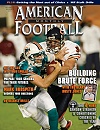Article CategoriesAFM Magazine
|
AFM Subscribers Ask – with Mark Hudspeth Head Coach, University of Louisianaby: AFM Editorial Staff© More from this issue Mark Hudspeth was appointed the 25th head coach at the University of Louisiana last December. He brings with him a reputation for a high-powered, no-huddle offense. Previously the Passing Game Coordinator/Wide Receivers Coach at Mississippi State and head coach at North Alabama, he brought the no-huddle concept to Starkville and now to the University of Louisiana. Hudspeth has a national championship, four conference championships, eight post-season appearances and four Coach of the Year awards on his resume. For seven seasons at North Alabama, the Lions went 66-20 and consistently scored 35-40 points per game. Hudspeth won a national championship while the OC at Division II Delta State where his offense broke 21 school records. His overall record as a head coach is 91-21. UL ....The full article can only be seen by subscribers.
|
|
|||||||
| HOME |
MAGAZINE |
SUBSCRIBE | ONLINE COLUMNISTS | COACHING VIDEOS |
Copyright 2025, AmericanFootballMonthly.com
All Rights Reserved





